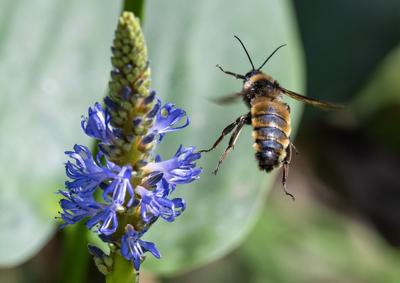On a recent walk with my pups, I noticed two things — the bees are starting to come out, and there are lots of ant piles in our neighborhood now. Both of these things can pose dangers to pets.
When pets are outside, it’s not enough to make sure they are in a secure yard or on a leash; also make sure that there is nothing in the grass or bushes that can harm them.
Insect bites can produce reactions ranging from mild irritation to life-threatening shock.
What should one do if the family dog or cat gets bitten by a bee or a wasp, or sticks his nose in a pile of ants? What if we don’t know exactly what bit our pet? How do we know how to properly treat the wound or manage the reaction if we are unsure of the culprit?
BE VIGILANT: If Fido comes inside and starts chewing at his paws or rubbing his face with his paws, he may be reacting to something he encountered outdoors. Swelling on any area of the body is an even more definitive sign that he has been bitten and is having a reaction.
IDENTIFY THE CULPRIT: It may be difficult to find the cause, but it is worth investigating. Check outside to see if there are any bees, wasps, spiders, ants and the like in the area. Look for snakes, too.
TREAT THE BITE: Check the area of the wound or swelling to see if there's any evidence present, such as a bee stinger or an ant. Next, try to get him some pain relief. Make a thick paste of baking soda and water and apply it to the affected area. An ice pack can also be minimize swelling.
CALL YOUR VETERINARIAN: Some bites are worse than others, and dogs each react differently. Some can have a mild reaction, while others may be severely allergic to insect bites.
Allergic reactions are usually apparent within 20 minutes of the bite, but can also not appear for hours, so close monitoring of the pet after a bite or sting is important.
IS IT AN EMERGENCY: While most bites and stings will cause temporary pain, some can become life threatening. If the pet exhibits any of the following symptoms, regardless of whether a bite or sting is suspected, seek medical attention immediately:
- Difficulty breathing or wheezing.
- Significant swelling around the head or neck, as this can compromise breathing.
- Hives on the body — these will itch like crazy and the pet will need medication to alleviate the itching and combat the allergic reaction.
- Excessive drooling, as this could be a sign of swelling in the throat passage.
- Vomiting and/or diarrhea
- Disorientation, dizziness, lethargy
- Seizures
Pets are oblivious creatures. My dog will step right into a pile of ants if I’m not paying attention to where he is walking, and pets do not look for insects like bees before walking through clovers or rolling in the grass.
If Fido gets stung or bitten, call your veterinarian immediately discuss the signs and symptoms to look for should an allergic reaction occur.
Traci D. Howerton is the volunteer manager for Animal Rescue New Orleans, a nonprofit, volunteer-based, no-kill shelter. For more information on ARNO, visit www.animalrescueneworleans.org.

